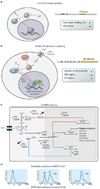Bursting into the nucleus
- PMID: 19109237
- PMCID: PMC2713346
- DOI: 10.1126/scisignal.151pe54
Bursting into the nucleus
Abstract
An increase in extracellular Ca(2+) induces the nuclear localization of the Crz1 transcription factor and the activation of target genes in yeast. A recent study indicates that nuclear entry occurs in short stochastic bursts that are unsynchronized within the population of cells. The frequency but not the amplitude of the bursts is controlled by Ca(2+). Modulation of the frequency of the burst coordinates aspects of expression of Crz target genes.
Figures


Similar articles
-
Frequency-modulated nuclear localization bursts coordinate gene regulation.Nature. 2008 Sep 25;455(7212):485-90. doi: 10.1038/nature07292. Nature. 2008. PMID: 18818649 Free PMC article.
-
A Noisy Analog-to-Digital Converter Connects Cytosolic Calcium Bursts to Transcription Factor Nuclear Localization Pulses in Yeast.G3 (Bethesda). 2019 Feb 7;9(2):561-570. doi: 10.1534/g3.118.200841. G3 (Bethesda). 2019. PMID: 30573469 Free PMC article.
-
Regulation of the Na+/K+-ATPase Ena1 Expression by Calcineurin/Crz1 under High pH Stress: A Quantitative Study.PLoS One. 2016 Jun 30;11(6):e0158424. doi: 10.1371/journal.pone.0158424. eCollection 2016. PLoS One. 2016. PMID: 27362362 Free PMC article.
-
Calcineurin-Crz1 signaling in lower eukaryotes.Eukaryot Cell. 2014 Jun;13(6):694-705. doi: 10.1128/EC.00038-14. Epub 2014 Mar 28. Eukaryot Cell. 2014. PMID: 24681686 Free PMC article. Review.
-
Yeast Gal4: a transcriptional paradigm revisited.EMBO Rep. 2006 May;7(5):496-9. doi: 10.1038/sj.embor.7400679. EMBO Rep. 2006. PMID: 16670683 Free PMC article. Review.
Cited by
-
Immunological synapse: a multi-protein signalling cellular apparatus for controlling gene expression.Immunology. 2010 Mar;129(3):322-8. doi: 10.1111/j.1365-2567.2009.03241.x. Immunology. 2010. PMID: 20409153 Free PMC article. Review.
-
Aspergillus fumigatus calcium-responsive transcription factors regulate cell wall architecture promoting stress tolerance, virulence and caspofungin resistance.PLoS Genet. 2019 Dec 30;15(12):e1008551. doi: 10.1371/journal.pgen.1008551. eCollection 2019 Dec. PLoS Genet. 2019. PMID: 31887136 Free PMC article.
-
Mechanisms of specificity in neuronal activity-regulated gene transcription.Prog Neurobiol. 2011 Aug;94(3):259-95. doi: 10.1016/j.pneurobio.2011.05.003. Epub 2011 May 18. Prog Neurobiol. 2011. PMID: 21620929 Free PMC article. Review.
-
Accurate encoding and decoding by single cells: amplitude versus frequency modulation.PLoS Comput Biol. 2015 Jun 1;11(6):e1004222. doi: 10.1371/journal.pcbi.1004222. eCollection 2015 Jun. PLoS Comput Biol. 2015. PMID: 26030820 Free PMC article.
-
The Mendelian disorders of the epigenetic machinery.Genome Res. 2015 Oct;25(10):1473-81. doi: 10.1101/gr.190629.115. Genome Res. 2015. PMID: 26430157 Free PMC article.
References
-
- Hoffmann A, Levchenko A, Scott ML, Baltimore D. The IκB-NF-κB signaling module: Temporal control and selective gene activation. Science. 2002;298:1241–1245. - PubMed
Publication types
MeSH terms
Substances
Grants and funding
LinkOut - more resources
Full Text Sources
Molecular Biology Databases
Miscellaneous

